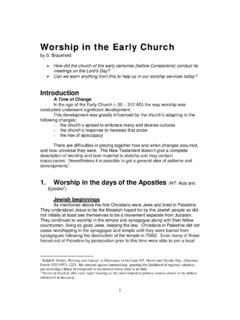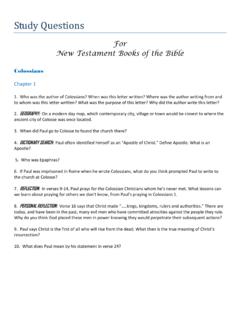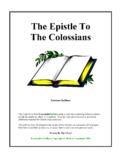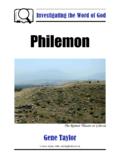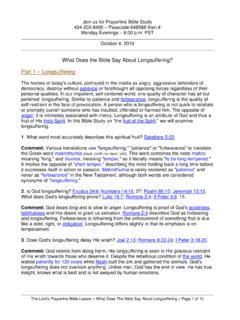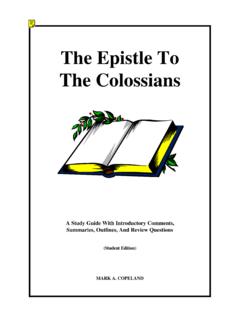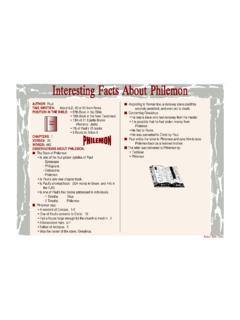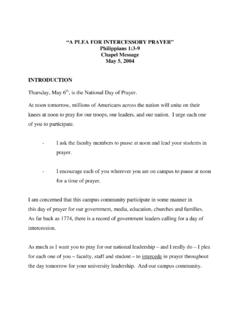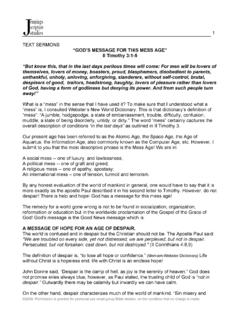Transcription of EPHESIANS - Evangelical
1 A Guide for Preachers and TeachersAndrew W. YoungGrace Theological CollegeAucklandNew ZealandEPHESIANSThe Church and God s Eternal Purpose in vINTRODUCING of the message of the value of the s great purpose in Christ for believers (1:1-3:21).. life worthy of this high calling (4:1-6:20).. 14 TEACHING AND PREACHING letter to saints (1:1-2).. in Christ Jesus (1:3-10).. in the blessings (1:11-14).. for God s people (1:15-19a).. Greatness of His power (1:19b-23).. alive in Christ (2:1-10).. new man in Christ (2:11-18).. longer foreigners (2:19-22).. minister to the Gentiles (3:1-6).. servant of the gospel (3:7-13).. Christ and his love (3:14-19).. to God forever (3:20-21).. the unity of the Spirit (4:1-6).. for growth (4:7-16).. on the new self (4:17-24).. of God (4:25-5:2).. sexual Immorality (5:3-7) .. in the light (5:8-14).
2 And Spirit-filled living (5:15-21).. wives (5:22-24).. husbands (5:25-33).. and children (6:1-4).. and slaves (6:5-9).. warfare (6:10-13).. armour of God (6:14-18).. for boldness (6:19-20).. words (6:21-24).. 72 FOCUSING Triune God .. great salvation .. church God s holy people .. new life in Christ .. things to come .. 81iiABSORBING 104iiiPREFACEThis Guide is designed to help people teach and preach the book of EPHESIANS . It is not a commentary but a series of notes and outlines aimed at helping Bible students grasp the message of EPHESIANS , the meaning of its text, and its relevance for today. It has been born out of ten years of teaching courses in biblical theology and preaching. Doing so has impressed me with the special need today schurch has for teaching and preaching that grapples seriously with the text of Scripture in the context of the overall message of the Bible.
3 Biblical theology (the study of theology from the viewpoint of its progressive revelation in history) and exegesis(the study of the meaning of the text in its original historical setting) are essential tools for doing this. They have been brought together in this Guide to enable the teacher and preacher to see more quickly into the meaning and message of the book of EPHESIANS . It needs to be understood that the aim in providing this Guide is not to relieve teachers and preachers of the need for their own diligent study. Nor is it intended to rob them of their creativity in outlining and writing sermons. It simply attempts to help them do these things more quickly by providing the focus that can be so hard to discover in expounding the Bible. This Guide contains five sections. The first introduces the background, message and relevance of the book of EPHESIANS .
4 It helps appreciate the circumstances in which the letter was written and how it can be used today. Extensive endnotes provide comments and quotations for those looking for more scholarly insights. The second section is an interpretive outline of the contents of EPHESIANS . This provides an overview of the contents of the book in outline form and establishes a framework for appreciating the contribution of its individual third section of the Guide looks closely at the text of EPHESIANS itself. It contains mechanical layouts, analytical outlines, unifying ideas and statements of relevance and purpose for individual sections of the letter. These are based on the approach to preaching outlined by Haddon W. Robinson in his book Biblical fourth section focuses the main themes of EPHESIANS and the fifth provides a devotional supplement to help teachers and preachers think their way deeply into the book.
5 To accomplish the latter the text has been broken down into a number of small sections and questions and suggestions for reflection provided for each. If this Guide (and others that may follow) helps those who minister God s word to do so more effectively it will have fully served its purpose. It is dedicated to seeing God glorified and his church strengthened through a full and faithful exposition of the mystery of Christ. Andrew YoungAuckland, New ZealandJuly 20011 Haddon W. Robinson, Biblical Preaching(Grand Rapids:Baker, 1980)4 INTRODUCING TO THE and Readers: EPHESIANS is a letter written by the apostle Paul to Christians in Asia Minor while he was in prison in Rome some time around the year 63 can be little doubt that Paul wrote this letter while he was in prison (3:1,13; 4:1). Some scholars think he was being held in the Roman garrison in Caesarea Philippi at the time, but the majority regard it as one of the prison epistles from Rome.
6 As such, it is a companion letter to Philippians, Colossians and it has been understood to be a letter to the church in Ephesus, a prominent city in the western part of Asia Minor (modern Turkey). But a number of factors cast doubt as to its original destination. For one thing, it lacks the warmth one might expect of a letter written to a church so well known to the apostle. For another, it appears that Paul may not have actually met some of his readers (see 1:15 for example). recently it has become popular to think of EPHESIANS as a circular letter written to a number of churches in and about some older manuscripts the word Ephesus is missing from the opening verse, pointing to the possibility that Paul originally left the destination blank. He may have intended the letter for a number of churches, copies of which could be supplied with the name of the church inserted in each, much as we address circular letters shall perhaps never know for sure whom this letter was written to.
7 Carson, Moo and Morris are correct when they write In the end we must probably conclude that we do not know for sure for whom the letter was originally intended. The evidence of the great mass of the MSS and the improbabilities of all the other views may drive us back to the view that it was meant for the church at Ephesus. If we feel that the absence of characteristic Pauline expressions of warmth (which would be probable in a letter to a church where he had spent as much time as he did at Ephesus) and of references to concrete situations are significant, then we will probably think of some form of circular. But we are left with difficulties whichever view we adopt. ivFor the purposes of this study we will adopt the view that Paul did write this letter to the church at Ephesus, knowing as he did so that its contents were applicable not simply to one church, but to all of the churches in western Asia and Purpose: Paul apparently wrote this letter to fit in with the planned visit of Tychicus and Onesimus to Ephesus rather than in response to any definite crisis in the occasion for the letter can be described in this way.
8 While in prison in Rome Paul came into contact with a runaway slave named Onesimus. Through the apostle s preaching Onesimus became a believer and a valued as Paul wanted to keep him with him, he saw it necessary to return him to his owner, a Christian man by the name of Philemon who lived in the city of colosse in Asia Minor. To pave the way for his reacceptance, he wrote a delicate letter (our NT letter of Philemon) encouraging Philemon to welcome his truant slave back. At the same time, hearing that false teaching was causing trouble in the church of colosse (presumably through its founder, Epaphras, who was with Paul at the time),vithe apostle also wrote a letter to the church as a whole (the NT letter of Colossians) to warn it against errors threatening its health. Both of these 5letters he entrusted to one of his co-workers, a native of Ephesus named Tychicus,viiwho was to accompany Onesimus on the order to reach colosse , Tychicus and Onesimus had to sail to Ephesus.
9 From there they would strike out east to the Lycus Valley via the main Roman road to the Euphrates. Given Paul s long and close association with the church in Ephesus, nothing could have been more natural for him than to write a letter for the two travellers to deliver to it as they made their way to colosse . There were seemingly no particular problems in the church demanding urgent pastoral attention so he was able to write in a positive, non-controversial way. Realizing that Tychicus and Onesimus would also be in contact with other churches on their journey as well (in major towns like Magnesia, Tralles, Hierapolis and Laodicea), he may have written with an eye to copies of this letter being left with them too accounting for the circular letter theory not dominated by any single pastoral issue,ixthe letter to the EPHESIANS does touch on topics that any church in western Asia Minor would have found relevant at the time.
10 Most of them were made up largely of Gentiles and in many cases were probably experiencing Jew-Gentile tensions as converts grappled to reconcile the Jewish heritage of the church with their own Gentile background. Again, given their pre-Christian way of life and the social environment in which they existed, the threat of syncretism and relapse into pagan ways must have been constantly present. Furthermore, it is well known that the people of the region lived in dread of spiritual powers, and new believers probably still felt a certain fear towards of these matters are dealt with decisively in this letter, supporting the idea that though non-specific, it nevertheless was aimed at providing pastoral encouragement for a range of needs facing churches at that has stated the purpose of the letter well in saying that it was written predominantly to Gentile Christians "to advance their understanding of the glory of their redemption and encourage them to proper conduct in keeping with their faith.
